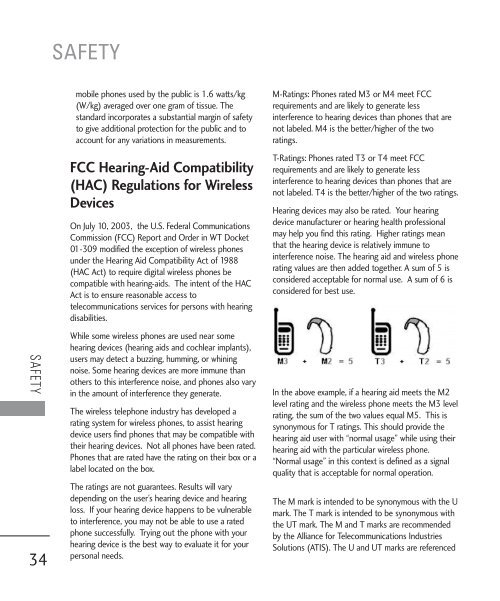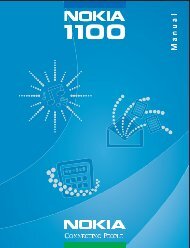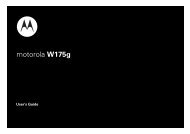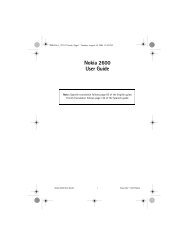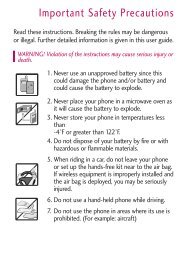You also want an ePaper? Increase the reach of your titles
YUMPU automatically turns print PDFs into web optimized ePapers that Google loves.
SAFETY<br />
34<br />
SAFETY<br />
mobile phones used by the public is 1.6 watts/kg<br />
(W/kg) averaged over one gram of tissue. The<br />
standard incorporates a substantial margin of safety<br />
to give additional protection for the public and to<br />
account for any variations in measurements.<br />
FCC Hearing-Aid Compatibility<br />
(HAC) Regulations for Wireless<br />
Devices<br />
On July 10, 2003, the U.S. Federal Communications<br />
Commission (FCC) Report and Order in WT Docket<br />
01-309 modified the exception of wireless phones<br />
under the Hearing Aid Compatibility Act of 1988<br />
(HAC Act) to require digital wireless phones be<br />
compatible with hearing-aids. The intent of the HAC<br />
Act is to ensure reasonable access to<br />
telecommunications services for persons with hearing<br />
disabilities.<br />
While some wireless phones are used near some<br />
hearing devices (hearing aids and cochlear implants),<br />
users may detect a buzzing, humming, or whining<br />
noise. Some hearing devices are more immune than<br />
others to this interference noise, and phones also vary<br />
in the amount of interference they generate.<br />
The wireless telephone industry has developed a<br />
rating system for wireless phones, to assist hearing<br />
device users find phones that may be compatible with<br />
their hearing devices. Not all phones have been rated.<br />
Phones that are rated have the rating on their box or a<br />
label located on the box.<br />
The ratings are not guarantees. Results will vary<br />
depending on the user’s hearing device and hearing<br />
loss. If your hearing device happens to be vulnerable<br />
to interference, you may not be able to use a rated<br />
phone successfully. Trying out the phone with your<br />
hearing device is the best way to evaluate it for your<br />
personal needs.<br />
M-Ratings: Phones rated M3 or M4 meet FCC<br />
requirements and are likely to generate less<br />
interference to hearing devices than phones that are<br />
not labeled. M4 is the better/higher of the two<br />
ratings.<br />
T-Ratings: Phones rated T3 or T4 meet FCC<br />
requirements and are likely to generate less<br />
interference to hearing devices than phones that are<br />
not labeled. T4 is the better/higher of the two ratings.<br />
Hearing devices may also be rated. Your hearing<br />
device manufacturer or hearing health professional<br />
may help you find this rating. Higher ratings mean<br />
that the hearing device is relatively immune to<br />
interference noise. The hearing aid and wireless phone<br />
rating values are then added together. A sum of 5 is<br />
considered acceptable for normal use. A sum of 6 is<br />
considered for best use.<br />
In the above example, if a hearing aid meets the M2<br />
level rating and the wireless phone meets the M3 level<br />
rating, the sum of the two values equal M5. This is<br />
synonymous for T ratings. This should provide the<br />
hearing aid user with “normal usage” while using their<br />
hearing aid with the particular wireless phone.<br />
“Normal usage” in this context is defined as a signal<br />
quality that is acceptable for normal operation.<br />
The M mark is intended to be synonymous with the U<br />
mark. The T mark is intended to be synonymous with<br />
the UT mark. The M and T marks are recommended<br />
by the Alliance for Telecommunications Industries<br />
Solutions (ATIS). The U and UT marks are referenced


